The Friends of the Wildflower Garden, Inc.
Plants of the Eloise Butler Wildflower Garden
The oldest public wildflower garden in the United States

Common Name
Monkey Flower (Allegheny Monkey Flower, Blue Monkey Flower, Square-stemmed Monkey Flower)
Scientific Name
Mimulus ringens L. var. ringens
Plant Family
Lopseed (Phrymaceae)
Garden Location
Woodland - marsh
Prime Season
Late Summer Flowering
Monkey Flower is an erect perennial native forb, growing from 6 to 40 inches high on smooth green 4-angled (square) stems with a groove on the sides. Much branching usually occurs from the lower part of the plant.
The leaves are opposite and stalkless, oblong to elliptical, up to 4 inches long, tapering on both ends with a central main vein and pairs of laterals that curve toward the margin. The stalkless base has a short pair of auricles that partially clasp the stem, but some lower leaves may not have the auricles. Margins have shallow coarse teeth. Each pair of leaves is rotated 90 degrees from adjacent pairs. The upper side is a medium green, the underside is much paler in color.
The inflorescence consists of solitary long-stalked flowers rising as a pair opposite each other from the leaf axils in the upper part of the plant. Flowers of the pair usually open on different days. Bracts are absent.
The flowers are 5-parted, about one inch long, with the sepals of the calyx forming a long 5-ribbed tube that ends with 5 very narrow pointed teeth at the end of each rib. The tube can have pinkish-blue tones. Flower stalks are 2 to 4 times as long as the calyx. The 5 petals are united at their bases to form a tube and exiting the calyx tube they form the corolla of 2 lips with the upper lip having 2 erect lobes and the lower lip 3 lobes with the middle lower lobe arching up into the open throat of the corolla. The base of the lower lip has fine yellowish hair on the inside obscuring the inside of the throat. Petals are pink to blue (some would say lilac-purple), rarely white. There are 4 stamens arranged in pairs of different length. The style has a 2-lipped stigma leading to a 2-locular ovary.
Fruit: Fertile flowers produce an oblong capsule 10 to 12 mm long, containing many small seeds (500 to 1000) that are oblong with a reticulated surface and dispersed by the wind shaking the stem. Seeds are extremely small, exceeding 2 million to the ounce. They require 60 days of cold stratification for germination and can only be surface sown, as would happen naturally - they need light to germinate. Pollination is usually by 3 species of worker bumblebees.
Habitat: Monkey Flower grows from a rhizomatous root system in moist areas such as marshes, wet meadows, and streambanks. It needs full to partial sun in wet to wet-mesic conditions. The plant can from small groups from the creeping rhizomes or from self-seeding. It is not aggressive in vegetative reproduction.
Names: The genus name Mimulus is the Latin diminutive of mimus, meaning 'a mimic', as the flower corolla is said to resemble (or mimic) the face of a monkey. The species, ringens, means 'gaping' and refers to the open throat of an open 2-lipped corolla. [note - this could apply to a number of flowers, particularly in the mint family.] The author name for the plant classification - 'L.' refers to Carl Linnaeus (1707-1778), Swedish botanist and the developer of the binomial nomenclature of modern taxonomy.
In earlier times M. ringens was classified in the Figwort family (the Scrophulariaceae), but has recently been assigned, after a century of discussion, to a new family of plants, the Phrymaceae, based on modern DNA analysis and the seed capsule design. This discussion of family change goes back to the early 1900s when botanists first suggested it. (see The Botanical Gazette, Vol. LVI, July-Dec. 1913.) See bottom of the the page for links to research abstracts about the change.
Comparisons: The shape of the corolla is somewhat unique, and with the pairs of pinkish to blue flowers rising from opposite leaf axils on long stalks, square stems, and moist habitat, there is not much to be confused with other Minnesota plants. Mint family plants also have square stems but the flowers are more clustered and not on long stalks. In a small corner of North America between New England and Quebec, there is a second variety, var. colophilus, but it is rare. It has shorter leaves and resides in freshwater tidal wetlands. Another species found in Minnesota is the James' Monkey Flower, M. glabratus var. jamesii, where the flower is yellow and leaves are almost round.
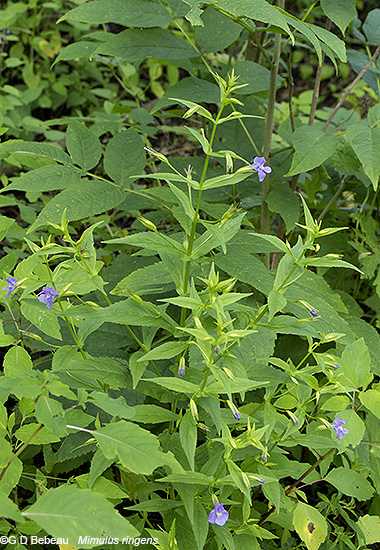
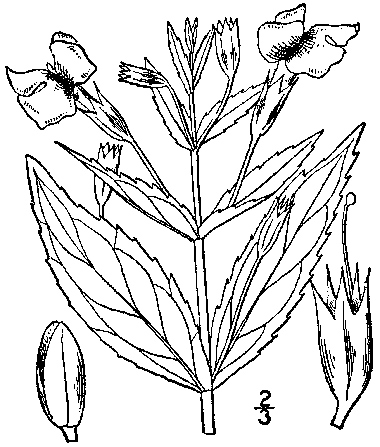
Above: Monkey Flower has opposite leaves with single flowers rising from the leaf axils. The stem usually branches as seen on this plant. Drawing from Britton, N.L., and A. Brown. 1913. An illustrated flora of the northern United States, Canada and the British Possessions. 3 vols. Charles Scribner's Sons, New York.
Below: 1st photo - The corolla has two lips with the upper forming 2 erect lobes and the lower lip with 3 lobes thrusting forward with the central lobe arched into the corolla throat. 2nd photo - The calyx also forms a tube with 5 ribs which terminate in thin needle-like teeth.
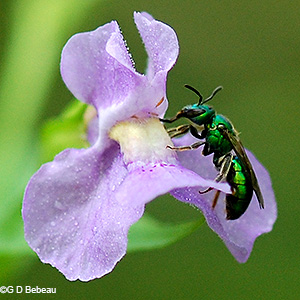
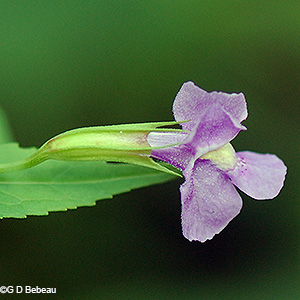
Below: 1st photo - view from above with the calyx to the left. 2nd photo - Flowers are solitary from the leaf axil an a long stalk. The flower on the opposite leaf usually opens on a different day.
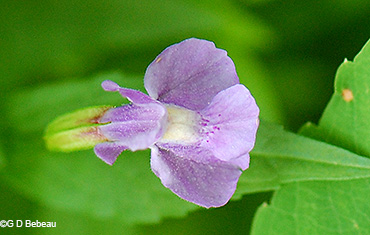
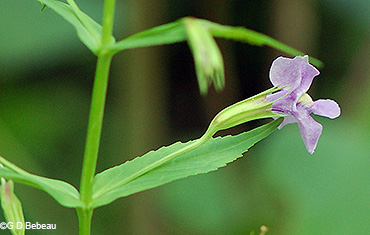
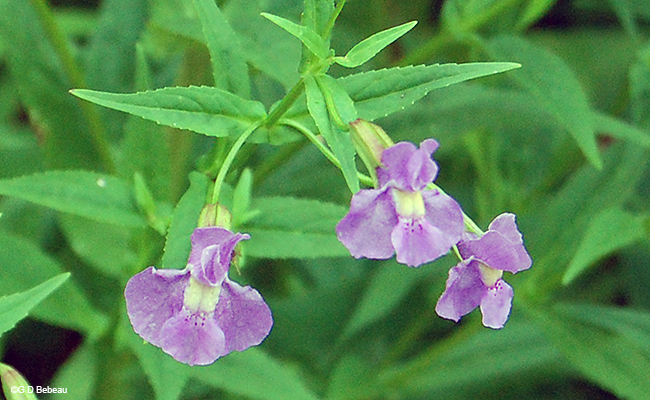
Below: 1st photo - the leaf upper side is medium green with shallow teeth. 2nd photo - the underside is much paler in color.

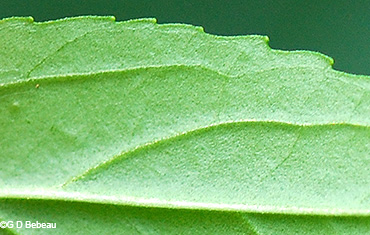
Below: Most upper stem leaves clasp the stem with a pair of short auricles at the leaf base.
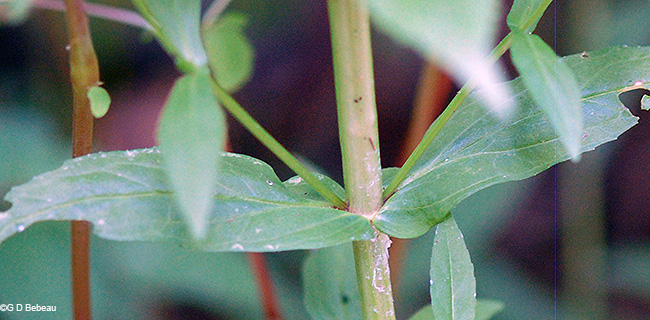
Below: The stem is 4-angled, smooth, with a groove on the sides.
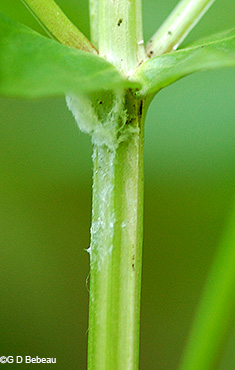
Below: 1st photo - the mature seed capsule. 2nd Photo - the minute seeds.
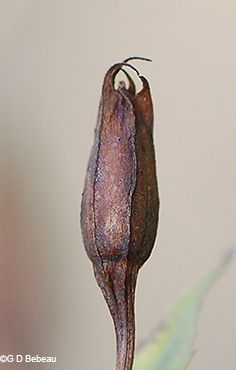
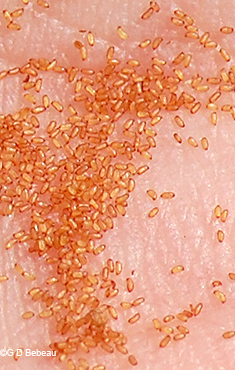
Below: A large Monkey Flower plant in the wetland of Eloise Butler.
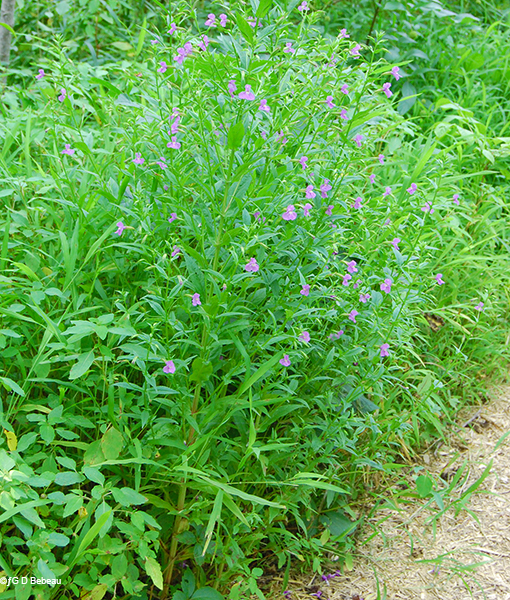
Notes: Monkey Flower is apparently not indigenous to the Garden as Eloise Butler did not list it as such, instead she introduced plants on July 15, 1910 that she had collected from Savage MN - now a metro suburb. She noted it in bloom the following year and in 1915 and 1916 she twice each year planted more and others in 1919. Martha Crone added plants in 1933, '46. '49 and planted seeds in 1948. Ken Avery added plants in 1961 and '63.
M. ringens is found in many counties in Minnesota, including most of the Metro area; the exceptions are in the western and southwestern part of the State where there are fewer marshes. The other Monkey Flower, M. glabratus var. jamesii is more restricted to the counties of the north central part of the state and along the St. Croix and Mississippi Rivers. In North America, M. ringens is found in all the states of the U.S. except Florida, Nevada, Utah, Wyoming, Arizona and New Mexico. In Canada it is usually found from Alberta eastward except Newfoundland and Labrador.
Research: 1: Researchers have observed what pollinators visit M. ringens, how many flowers get pollinated from bees visiting flowers on the same plant vs other plants and more interesting data on how the flowers are receptive to pollinators. This PDF was published in 2004. (142k)
2: An abstract of work done as part of the larger construction of the Phrymaceae family is contained in this extended PDF (1.8mb)
Return to -- Site Plan/Archive Index --or-- List of Common Plant Names -- or -- List of Scientific Names -- or --Home Page - - - Back to top.
References: Plant characteristics are generally from sources 1A, 32, W2, W3, W7 & W8 plus others as specifically applied. Distribution principally from W1, W2 and 28C. Planting history generally from 1, 4 & 4a. Other sources by specific reference. See Reference List for details.
 Identification booklet for most of the flowering forbs and small flowering shrubs of the Eloise Butler Wildflower Garden. Details Here.
Identification booklet for most of the flowering forbs and small flowering shrubs of the Eloise Butler Wildflower Garden. Details Here.
©2016
Friends of the Wildflower Garden, Inc. Text and photos are by G. D. Bebeau unless otherwise credited. "www.friendsofeloisebutler.org"
122321